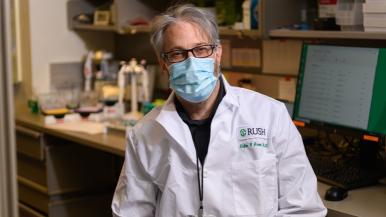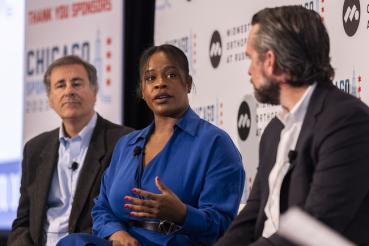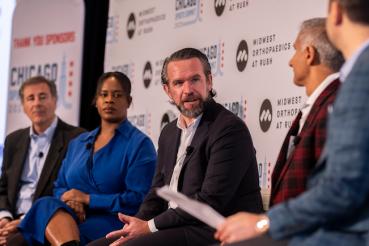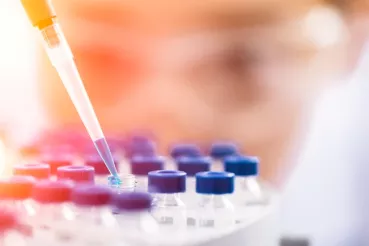Before every NASA mission, each spacecraft is tested to make sure it doesn’t contain too many microbes like bacteria, viruses and fungi that could potentially contaminate extraterrestrial planetary bodies like Mars. But current methods for determining how “clean” a spacecraft is can be slow and insufficient. That’s why NASA asked Stefan Green, PhD, a microbial ecologist and molecular biologist at RUSH, to help them develop new ways to keep space safe.
“We don’t want to contaminate places like Mars with microorganisms from Earth,” says Green, director of Core Laboratory Services and the Genomics and Microbiome Core Facility at RUSH. “This is critical from a general protection perspective but also for trying to detect life on other planets.” In other words, microbes from Earth could contaminate water or soil samples from other celestial bodies and lead to a false discovery of life on another planet.
Using genomic sequencing to test spacecraft
Determining the levels of microbes on a spacecraft before launch — a process known as “bioburden assessment” — is time-consuming and cumbersome because it involves collecting samples from surfaces of the spacecraft with small swabs and trying to grow organisms from those samples in Petri dishes in a lab.
“The problem is that over the last five decades in the field of microbiology, we’ve learned that there are an awful lot of organisms that we can’t cultivate,” Green says. “And some of these organisms may be relevant for what we call planetary protection — meaning that some might be able to survive space flight and contaminate any planetary body that the spacecraft lands on.”
To help NASA detect organisms aboard spacecraft, Green led an interdisciplinary panel of microbiologists, engineers and other experts at the agency’s Jet Propulsion Laboratory in Pasadena, California, earlier this year. Their goal was to find a faster, more precise tool that would use DNA sequencing to ensure that spacecraft are clean enough before launch. Instead of having to grow organisms from a swab sample, scientists would be able to extract the DNA from those samples and identify which organisms were on the spacecraft based on their DNA sequence, almost like a genetic thumbprint. The DNA sequence data may also inform scientists about the capabilities of the microorganisms on spacecraft, and this information could be used for risk assessments.
Applying technology used for COVID-19
Ultimately, the panel recommended testing spacecraft prior to launch with a hybrid molecular biology approach using DNA sequencing combined with another technology: quantitative polymerase chain reaction, or qPCR. While DNA sequencing can be used to discover new organisms that might be present on a spacecraft and provide hints to microbial capabilities, qPCR tests can be designed to quickly detect and quantify specific organisms that scientists already suspect are onboard spacecraft.
Quantitative PCR tests are the same technology that scientists at RUSH and elsewhere have been using to detect and quantify SARS-CoV-2, the virus that causes COVID-19, says Green, who is also co-principal investigator for the Regional Innovative Public Health Laboratory (RIPHL), a public-academic partnership with the Chicago Department of Public Health. Through RIPHL, Green and his team have been using genomic analysis on virus samples from across the city to trace emerging variants and other trends.
“When we’re doing SARS-CoV-2 surveillance, we have PCR tests that are looking for genes that are already known to be present in the virus. Conversely, to test for bioburden on spacecraft, we will utilize both general and specific PCR assays that look for genes present in all bacteria or fungi as well as specific genes of interest present only in certain bacteria or fungi,” Green says.
Green expects detailed guidance from the panel to be published later this year. “The recommendations could be used as a template for NASA going forward, but it takes a long time for new workflows to be implemented, and they have to go through incredibly rigorous validation,” he says.
From space to health care
Green first became connected with NASA through its astrobiology program as a postdoctoral research fellow at the Ames Research Center. During his time at Ames, he worked with a group of researchers investigating modern ecosystems (known as microbial mats) that serve as analogs of the earliest forms of microbial communities on Earth. He later got involved in research on the effects of spaceflight on the gut microbiome (the microorganisms in our digestive tract) with Ali Keshavarzian, MD, a gastroenterologist at RUSH, and was part of the research team for the NASA Twins Study, which looked at how the body changes during spaceflight. Currently, Green is co-investigator for another NASA research project testing the effects of spaceflight and diet on the gut microbiome in mice at the International Space Station.
Green says lessons learned from his most recent NASA project assessing bioburden on spacecraft could offer insights on better ways to detect and reduce harmful microorganisms in hospitals and other health care settings here on Earth.
“The primary crossover to non-spaceflight applications, including health care, is for assessing microbial bioburden in samples where there are very low levels of cells and total DNA, such as swabs from surfaces in hospitals that we use for routine testing,” Green says. “There may also be benefits on the data analysis side that would help us make rapid decisions about whether a spacecraft surface needs additional cleaning or if a hospital surface contains a possible pathogen.”




